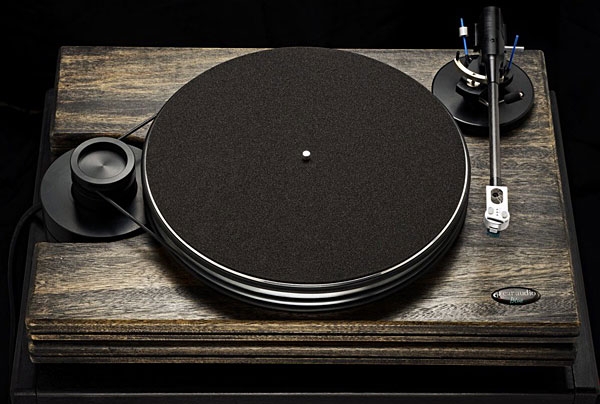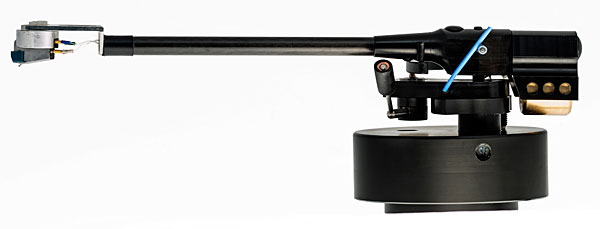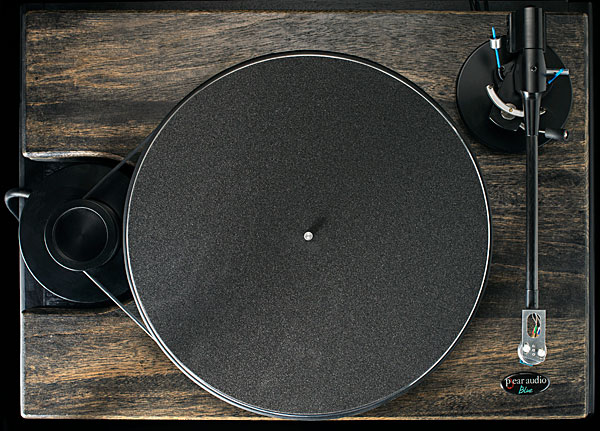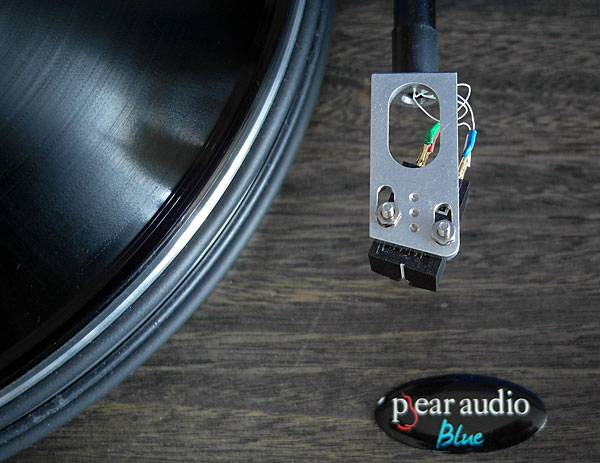| Columns Retired Columns & Blogs |
did hear it at CES 2015 paired with Larsen Speakers - the resulting sound was very engaging, musical and easy to sink into. Cool looking to boot!
Jerry Cmehil
Designer
Well Rounded sound Inc.

Key to the Space Deck's performance was the pairing of two seemingly incompatible components: a tiny, low-torque motor and a massive metal platter, the latter damped with rubber rings stretched around its perimeter. In declaring that such a thing can't possibly work, the casual observer is to be forgiven, at least to the extent that work means "get the platter turning." The Nottingham Analogue Space Deck did no such thing. Instead, users were politely asked to do it themselves by giving the platter a bit of a spin with their hands; once set in motion, the platter was kept spinning steadily, at the correct speed, by its small but perfectly formed motor, and by the flywheel effect enabled by the heavy platter's moment of inertia.
The reason for all that unusualness was Fletcher's belief that motor vibrations are a major obstacle, if not the major obstacle, to a high quality of playback of LPs. By keeping motor size to the absolute minimum, he minimized vibrations at their source.
The Space Deck sold well, and was joined in the Nottingham line by a number of other models—some cheaper, some more expensive—all based on the same ideas. And although in 2011 the company's success was dimmed by its founder's untimely death, Notts Analogue fans take comfort in knowing that today no fewer than four firms make phonographs designed for them by Tom Fletcher: AnalogueWorks, Fletcher Audio, Nottingham Analogue, and Pear Audio Analogue (footnote 1).
The last of those, unrelated to the makers of Pear Cables, is an offshoot of a European distribution company whose principal, Peter Mezek, has considerable experience with various high-end turntable brands. In fact, Mezek was the distributor for Well Tempered turntables and tonearms, until an interruption in the availability of that line led him to seek help from Tom Fletcher, who responded with the offer of a new record-player design. Production began in Nottinghamshire, UK—in the very heart of Sherwood Forest, we're told—but manufacturing has since moved to a factory in Ljubljana, Slovenia. The next-to-cheapest model in a line of four turntables, the Kid Howard is often bundled with Pear Audio's Cornet 2 tonearm, the combination selling for $4995. (When the two are purchased separately, the total cost is $295 higher.)
Before diving in, a word about names: Pear Audio Analogue is the name of the company that manufactures these products, while Pear Audio Blue—the last word a reference to Mezek's dog, of whom Fletcher was especially fond—is the name of their product line. Because overly complex names result in clumsy sentences and reviews that read like press releases, I've taken the liberty of streamlining.
Description
Pear Audio's Kid Howard turntable is built on a single-layer, 1.75"-thick solid plinth of relatively low-mass wood whose weight and grain suggest poplar or perhaps very lightweight ash. (Pear's Peter Mezek declined to identify the wood used.) To make room for the outboard motor pod, a U-shaped chunk of wood about 5" wide by 5" deep is cut away from the left side of the plinth. The pod comprises inner and outer cylinders, both machined from an acetal plastic; the motor itself is rigidly fixed to the inner cylinder, whose height can be adjusted by means of its friction fit within the outer cylinder. The motor is topped with a stepped plastic pulley that drives the platter by means of a soft-rubber circumferential belt similar in cross-section to bucatini.
The Kid Howard's 17-lb aluminum-alloy platter is fitted with a stainless-steel bearing spindle 0.4" in diameter. The business end of the spindle is neither flat nor conical, but machined to a shape, best described as a nub, whose flat contact area measures a mere 0.085" across. In use, this nub bears down against a convex thrust pad machined into the bottom of the brass bearing well, the latter containing a bath of light oil. Given the Kid Howard's apparent dependence on angular momentum, for speed stability, I was surprised that its platter's mass is not concentrated near its circumference, as in many other platters. Instead, the platter's thickness is uniform over most of its area.

Bolted rigidly in place in the right-rear corner of the plinth is a round, acetal armboard 4" in diameter. In addition to that and the motor and the bearing, the Kid Howard's plinth incorporates a fourth element: Under the platter, to the right of the main bearing, a round hole 1.75" in diameter has been drilled straight through the plinth. The bottom of the hole is occluded by a thin acetal plate, through which passes a length of soft but stiff rubber pipe, the top end of which is allowed to brush lightly against the underside of the spinning platter. I wondered if this resistive element in the drive system was intended to increase effective torque at the disc-stylus interface—like other aspects of the Kid Howard's design, the pipe is not mentioned in the owner's manual. Mezek corrected my misimpression, describing this "tail" as "a mechanical speed enhancer" whose slight resistance increases the rotational stability.
Pear Audio's Cornet 2 tonearm is a unipivot design with a spindle-to-pivot length of 222mm; combined with an overhang of 12mm or so, that would make its effective length approximately 234mm, or 9.2". The unipivot is "captured" in the sense that the top portion of the bearing can't be completely removed from its base, but there seemed to be considerable play in the bearing: the top was free to be moved, from side to side and fore and aft. (The top can also be lifted straight up, but to a much smaller degree.) The Cornet 2's headshell area, which lacks a fingerlift, is machined from aluminum alloy; the armtube is made of carbon fiber, and the counterweight is brass. Otherwise, with a few very minor exceptions, the rest of the tonearm is machined from acetal. Skating compensation is of the (uncalibrated) falling-weight type, using not a thread but a very lightweight metal lever, bent into a shape similar to the "longhorn" hand gesture popular among heavy-metal musicians and some US Presidents. The tonearm's height is adjustable, either manually or by means of a vertical setscrew that raises or lowers the arm's acetal gantry relative to the armboard.

Fit and finish on my sample were mostly quite good. The tallish platter, though not perfectly free from runout error, was nonetheless better than average in that regard, and its outer edge was nicely polished; the plastic motor pulley, too, was free from apparent defect. The unipivot bearing of the Cornet 2 tonearm, being wobbly when handled—but presumably not during actual record play—confounded my efforts at measuring friction. Of those visitors to my home who commented on the Pear Audio's appearance, almost all were impressed, many commenting on the attractiveness of its matte-finish wooden plinth.
Installation and setup
From carton to console, setup time was minimal for the Pear Audio Kid Howard. I was required only to: level the plinth by adjusting its three large, multi-padded feet; apply to the bearing well a small amount of oil; lower into place the bearing spindle and platter; position the motor pod within its cutout; adjust the motor's height; install the drive belt; and attend to all of the usual chores of cartridge installation and adjustment.
As for the latter: As in most tonearms, the Cornet 2's headshell is slotted to permit the setting of overhang; the range of adjustment proved sufficient to attain correct Baerwald alignment, measured with a DB Systems protractor (footnote 2), with all three of the pickups I tried: the Denon DL-103, the Miyabi 47, and the Miyajima Premium BE Mono II. Initially, I used the headshell's angled front edge as a guide in establishing offset, but that angle proved insufficient with all three pickups, necessitating a slight extra measure of clockwise rotation, as viewed from above.

The fanfare accorded technological breakthroughs may be withheld from the Cornet 2's uncalibrated downforce mechanism, which is set by adjusting the position of a brass counterweight relative to the arm's fulcrum, within the weight's acetal carrier: a friction fit in the manner of the above-mentioned motor mount. Once I got the hang of how much thumb pressure equaled how much travel fore or aft, this was quite easy. Less than easy was adjusting the height of the Cornet 2: Because the tonearm mount is of such large diameter, and because it's made without an upper collet of any sort, the grub screw that secures the arm pillar is snugged into the far end of a recess unusually deep, even given the oblique angle at which the recess was machined. Because that screw is nonetheless quite short, and because it's made of nylon rather than metal, it was the very dickens to turn. Proponents of making fasteners "Linn-tight," an inclination on which I'll withhold judgment, will be confounded.
Used with the Denon '103 cartridge, the Cornet 2 tonearm exhibited lateral and vertical resonant frequencies of 15 and 14Hz, respectively, observed with the aid of Hi-Fi News & Record Review's colorfully titled Test Record (LP, Hi-Fi News HFN 001). Neither mode was terribly pronounced, and those numbers are acceptably low, if only just: I couldn't help concluding that the Denon might be just a shade too low in compliance for the moderate-mass Cornet 2. A slightly better match was seen with the Miyabi 47, whose numbers were 13Hz lateral and 10–12Hz vertical, the latter anomaly perhaps explained by the maturity of the Miyabi's suspension. I didn't test the Miyajima, even with just the Test Record's lateral band, out of concern that the cartridge's lack of vertical compliance might result in damage to the groove.

Observed with the aid of the 3150Hz tone on Dr. Feickert Analogue's 7" test record and ProgTec's PlatterSpeed software for the Apple iPhone, the Kid Howard's actual speed ranged between 34.14 and 34.25rpm. Wow, in accordance with DIN IEC 386, was ±0.1% using the 2-Sigma method, and ±0.09% with dynamic weighting. But the next day, using the same measurement regimen, I found a mean frequency of 3229.9Hz and ±0.11% wow using 2-Sigma, and a more considerable ±0.19% wow using dynamic weighting. None of those numbers was cause for extreme concern, although levels of wow above 0.2% would be.
Footnote 2: The Pear Audio player comes with a paper protractor labeled "Polaris Plus Stylus Alignment Gauge." Like Mobile Fidelity Sound Lab's unlamented Geodisc, it's the sort that requires the user to aim a sight line directly at the tonearm's precise pivot: never a recipe for accuracy, in my experience. The Polaris's results did not agree with those of my dB protractor, in which I have the greater faith, although the Polaris did agree that the cartridge offset angle should be greater than that suggested by the headshell's angled edge.

did hear it at CES 2015 paired with Larsen Speakers - the resulting sound was very engaging, musical and easy to sink into. Cool looking to boot!
Jerry Cmehil
Designer
Well Rounded sound Inc.

I have noticed in the last several reviews that Mr. Dudley has done his reviews without his TD124 and only the Garrard 301. I wonder why?

Hi Volvic—I have tended to lean on one when the other requires work, and for the past several months I've been challenged in my efforts to get the TD 124's plinth just so. I'm getting closer—a good saw comes in handy—and in any event you'll see much more of the 124 beginning in the September and October issues and beyond. Thank you for reading my columns and reviews.